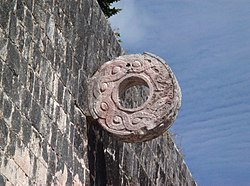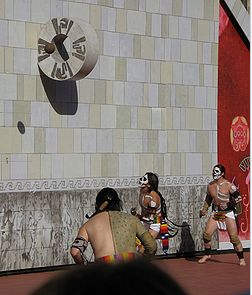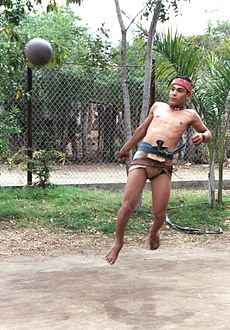The ōllamalīztli - Pok-Ta-Pok - Ulama
The ballgame (Nahuatl languages: ōllamalīztli, was a sport with ritual associations played since at least 1650 BMD. The sport had different versions in different places during the millennia, and a newer, more modern version of the game, ulama, is still played by the indigenous populations in some places.
The rules of the original ballgame are not known, but judging from its descendant, ulama, they were probably similar to racquetball, where the aim is to keep the ball in play. The stone ballcourt goals are a late addition to the game.
In the most common theory of the game, the players struck the ball with their hips, although some versions allowed the use of forearms, rackets, bats, or hand stones. The ball was made of solid rubber and weighed as much as 4 kg (9 lbs), and sizes differed greatly over time or according to the version played.
The ballgame had important ritual aspects, and major formal ballgames were held as ritual events. Late in the history of the game, some cultures occasionally seem to have combined competitions with religious human sacrifice. The sport was also played casually for recreation by children and may have been played by women as well.
The ballgame is known by a wide variety of names. In Common, it is often called Pok-ta-Pok (or pok-a-tok).
Ulama games are played on a temporary court called a tastei (
[tas.te], the Nahuatl word meaning "ballcourt"). The bounds of these long narrow courts are made by drawing or chalking thick lines in the dirt. The courts are divided into opposing sides by a centerline, called an analco. A ball that is allowed to cross the end line, the chichi or chivo, will result in a point scored for the opposing team. Points or rayas ("lines", so named for the tally marks used to keep score) are gained in play. The scoring system provides for resetting the score to zero under certain conditions, which can make for lengthy games.
The modern-day game has three main forms:
Ulama de cadera or hip ulama. A hip ulama team consists of five or more players (but there could be as many as twelve) wearing loincloths, with leather hip pads for some protection against the heavy (3-4 kg, around 7-9 lb) rubber ball.
Ulama de antebrazo or forearm ulama. Played on a smaller field, with teams of one to three players and a ball lighter than that of hip ulama, the game requires the players to return the ball using their wrapped forearm. Women often play this game.
Ulama de mazo or Ulama de palo, in which a heavy (6–7 kg or 13-15 lb) two-handed wooden paddle strikes a 500g (1 lb) ball, usually in teams of three or four.
The object of the game is to keep the ball in play and in bounds. Depending on the score and the local variant of the rules, the ball is played either high or low. A team scores a point when a player of the opposing team hits the ball out of turn, misses the ball, knocks the ball out of bounds, touches the ball with any part of the body aside from the hip, accidentally touches a teammate, lets the ball stop moving before it reaches the centerline, or even if they fail to announce the score after they have scored a point.
The first team that scores eight points wins. If both teams end up having the same number of points after a turn, both sides begin again from zero. One record-setting game reportedly lasted for eight days. Most modern games are stopped after about two hours.
Remove these ads. Join the Worldbuilders Guild












Comments